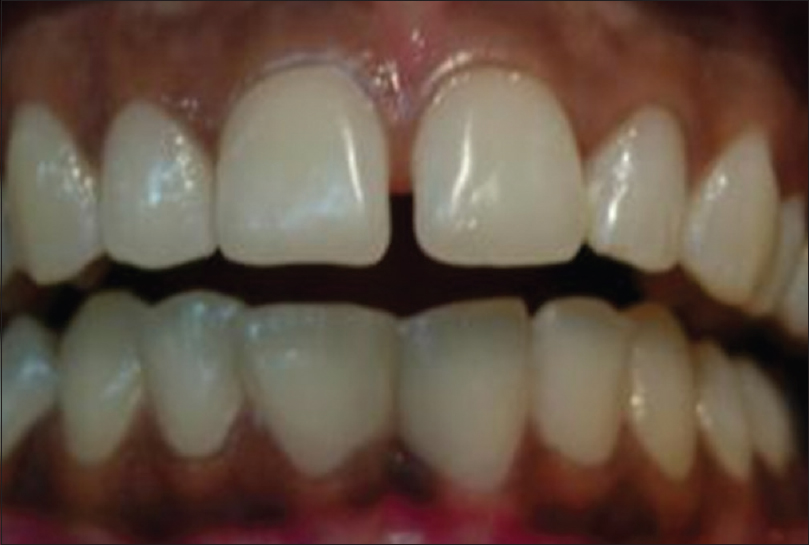Table of Contents
This article has been written by Dr. Sushma Sharma who is a medical practitioner. We would like to thank her for joining us and sharing her thoughts with the world.
The midline diastema is present in a significant portion of the general population. These spaces may be generalized i.e spaces may be found evenly in all teeth or localized i.e spaces between specific teeth.
The localized space between two front teeth in upper jaw is termed as midline diastema. Diastema means interval in Greek.
The midline diastema is a space (or gap) greater than 0.5mm between the two adjacent surfaces of maxillary central incisors (middle two teeth in front in upper jaw). People with midline diastema may be self-conscious about having a space between their teeth. However, a diastema also can affect speech especially “s” and “th’. In France, the teeth present on both sides of spacing are called as Dents Du Bonheur or ”Lucky teeth”.
Also Read: Pyaria Symptoms, Cure and Treatments
In Nigeria, gaps between teeth is considered an exceptionally attractive physical trait. Diastema are prominently displayed in the mouths of many renowned personalities from different walks of life like David Letterman, Elton John, Eddie Murphy, Madonna, Lauren Hutton, Michael Strahan, Arnold Schwarzenegger, and Condoleezza Rice, to name a few. Here, I shall explain Midline diastema ,its asthetic impacts and treatment.
10 Causes of Midline Diastema
- Genetic and familial history
- Physiological: Developing dentition
- Supernumerary teeth (Extra teeth )
- Abnormal frenum: High attachment of labial frenum (fold of the mucous membrane connecting the lip to upper jaw). A simple blanching test is performed for an abnormal high frenum.
- Tooth material – arch length discrepancy: condition such as missing teeth, microdontia ( small size teeth), peg shaped lateral incisors, macrognathia (large jaw size)
- Habits: Habits such as thumb sucking or tongue thrusting can cause procliantion of teeth, which causes midline diastema along with generalized spacing
- Midline pathology: soft tissue and hard tissue pathologies such as cysts, tumors and odontomes may cause midline diastema
- Iatrogenic or treamemt related: rapid maxillary expansion can cause midline diastema due to opening of the intermaxillary suture
- Imperfect fusion of bones at the midline
- Gum diseases
When to Worry for Midline Diastema?
Midline diastemata (or diastemas) occurs in approximately 98% in 6 year olds, 49% in 11 year olds and 7% in 12– 18 year olds. In case of normal physiological development, diastemas of less than 2mm in nine-year-old children generally is closed by the time the maxillary canines erupts. For some individuals, however, the diastema does not close spontaneously. In adults with wider diastemas, braces are required.
Treatment Options for Midline Diastema
Ruling out etiology and correct diagnosis is imperative to attain aesthetic results but to maintain the stability of the results attain as the chances of opening of the spaces post treatment is higher in case of Midline diastema.
Treatment strategies are made keeping in mind etiology of diastema, age of the patient, other associated anomalies, normal growth and development, tooth size discrepancies, excessive incisor vertical overlap of different causes, inclination and angulation of teeth, generalized spacing and gum conditions.
- If your lateral incisors are too small, your dentist may suggest widening them using crowns, veneers or bonding.
- If you have a space because you are missing teeth, you might need more extensive dental repair. This might include dental implants, a bridge or a partial denture.
- If the gap is caused by periodontal disease, then periodontal treatment by a dentist or gum specialist (periodontist) is necessary.
- Pathological causes like supernumerary teeth, midline soft tissue anomalies can be removed surgically and spaces are closed orthodontically.
- Oral habits such as thumb sucking and tongue thrusting should be corrected before closure of the space.
Only Restorative Treatment for Midline Diastema
- Tooth colored material filling(Composite)
- Laminates or veneers
- Ceramic Crowns
- Implants in case of missing lateral incisors
Only Orthodontic Treatment for Midline Diastema
- Removable plates
- Braces
Restorative Treatment and Orthodontic Treatment
Large spaces or other associated dental anomalies may require combination of treatment with braces followed by restorative treatment.
Midline Diastema Post Treatment
In wider diastemas this retention should be permanent. A bonded fixed retainer on inner surface of front teeth is recommended. Frenectomy or incision of frenum is done after space closure in case of high frenum attachment to decrease chances of relapse.
Frequently Asked Questions on Dental Health
1. Oral Cancer- Early Signs and Risk Factors
2. Midline Diastema – Causes and Treatment Options
3. 5 Dental Treatments to Enhance Your Smile
4. Importance of Dental Visit for Infants
5. Dental Tourism in India – Advantages and Disadvantage
6. Can Eating Disorders effect Dental Health?
7. How to Reverse Tooth Decay and Dental Caries with Diet?
8. Complete Information on Mouthwash for Dental Health
9. Dental Myths and Facts in Society-by Dr. Sushma Sharma(Dhiman)
10. Oil Pulling-Benefits, Tips and Methods for Dental Health
11. 4 Great Tips to Help You with Your Smile Makeover
12. What Are The Early Signs Of Gum Disease?
13. 7 Ways to Treat Gapped Teeth Effectively
14. Should I Go to the Dentist When I’m Sick?
15. Habits Start Young: 4 Ways to Implement a Healthy Routine for Your Kids
16. Receding Gums: Causes, Symptoms, and How to Treat Them
17. How to Get Your Biggest, Brightest, and Whitest Smile
18. How Menopause affects Oral Health?
19. Tongue tie in children-know all about the symptoms and cure
20. How to Deal with Black Spaces in your Teeth
21. The Effects of Enlarged Tonsils on Dentition
22. 8 Amazing Benefits Of Baking Soda And Lemon for teeth
23. What Should we Eat and Avoid with Braces?
23. 9 Traditions to Dispose of Lost Milk Teeth
24. Thumbsucking in Kids, causes and impact
25. Pacifiers for Kids, risks and benefits





